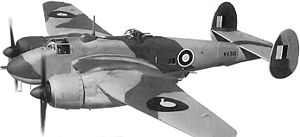Bristol Buckingham Video - Picture

|
|
Bristol Buckingham
Type 163 Buckingham

Picture - bomber version of Buckingham
Role: Courier aircraft
Manufacturer: Bristol Aeroplane Company
First flight: 4 February 1943
Primary user: Royal Air Force
Produced: 1943-1945
Number built: 119
Variants: Bristol Brigand
The Bristol Type 163 Buckingham was a British Second World War medium bomber for the Royal Air Force (RAF). Overtaken by events, it was built in small numbers, and was used primarily for transport and liaison duties.
Design and development
In early 1939 Bristol suggested a bomber variant of the Beaufighter with their Hercules engines. British policy at the time was for medium bombers to be provided from the US allowing British industry to concentrate on heavy bomber designs but a design was requested preferably based on an existing design which effectively meant working with the Beaufighter or Beaufort. Bristol worked on their design first as the Bristol Type 161 then the Type 162 Beaumont.
Air Ministry specification B.7/40 called for a medium bomber to replace the Blenheim. The specification stipulated a speed of at least 300 mph with a normal load of 1,000 lb of bombs and turret armed with at least two machine guns of 0.50 inch calibre. Only one manufacturer tendered a full design but it did not meet with approval. Bristol then brought their Type 162 to the Air Staff which was fortunately well matched to B.7/40 and led to a request for a completed mock-up and then a contract for three prototypes in late 1940. The Beaumont was based on the rear fuselage and tail of a Beaufighter with a new centre and front fuselage. The armament was a mid-upper turret with four machine guns, four more firing forward and two firing to the rear.
Construction began in late 1940, with a new Air Ministry Specification B.2/41 to be written around it. However changes in the requirements - removing dive bombing and "direct army support" which incoming US bombers were expected to be capable of - and increasing the performance requirement to allow for the future meant the Beaumont would no longer suffice. The changes in performance (requiring a bombload of 4,000 lb, a speed of 360 mph and a range of 1,600 miles) meant a redesign by Bristol to use the Bristol Centaurus engine..
Bristol redesign with a larger wing and the more powerful engines was the Type 163 Buckingham. It had gun installations in the nose, dorsal and ventral turrets. Generally conventional in appearance, one unusual feature was that the bomb-aimer/navigator was housed in a mid-fuselage ventral gondola. this was part of an attempt to give all the crew positions unobstructed views and access to each others positions. The bomb bay could hold a single 4,000 lb, two 2,000 lb, four 1,000 lb or six 500-lb bombs. The rear of the gondola had a hydraulically powered turret with two 0.303 Browning machine guns. The dorsal turret of Bristol's own design carried four Brownings. A further four fixed, forward-firing Brownings were controlled by the pilot.
Following more changes specification B.2/41 was subsequently replaced with B.P/41. The first flight took place on 4 February 1943. During testing, the Buckingham exhibited poor stability which necessitated the enlargement of the twin tails along with other modifications.
Operational history
By the time the design entered production, the requirements had already changed, daytime operations were being covered by the US and this sort of duty generally fell to night missions with the de Havilland Mosquito instead.
The Buckingham bomber was therefore cancelled in August 1944. However in order to keep Bristol's workforce together for later production of the Brigand and the Hawker Tempest a batch of 119 had to be built. Uses for the aircraft were sought and a conversion to a communications aircraft was devised. After the first 54 had been built as bombers, the remainder were converted for high-speed courier duties with RAF Transport Command. The gun installations were removed and four seats and windows fitted in the fuselage. The aircraft were designated Buckingham C. Mk I. Despite its 300 mph (480 km/h) speed and superior range to the Mosquito transports, with only room for four passengers, the Buckingham was rarely put to use. A total of 65 Buckingham bombers were unfinished on the production line and ended up re-built as the Buckmaster transport, a close derivative. The Buckmaster was also further modified for use as a trainer for the similar Brigand. Considered the "highest performance trainer in the RAF," the Buckmaster continued to serve as a trainer until its eventual retirement in the mid-1950s.
Operators
United Kingdom
Royal Air Force
Specifications (Buckingham C. Mk I)
Data from Flight
General characteristics
Crew: 2
Capacity: 4 passengers
Length: 46 ft 10 in (14.3 m)
Wingspan: 71 ft 10 in (21.9 m)
Height: 17 ft 6 in (5.3 m)
Wing area: 708 ft² (65.8 m²)
Empty weight: 24,042 lb (10,900 kg)
Loaded weight: 34,000 lb (15,000 kg)
Powerplant: 2x— Bristol Centaurus VII air-cooled radial engine, 2,520 hp (1,880 kW) each
Performance
Maximum speed: 336 mph (291 kn, 541 km/h) at 12,000 ft (3,700 m) with "S gear"
Range: 2,300 mi (2,000 nmi, 3,700 km) at sea level and 165 mph. 3,000 miles with two 185 gallon tanks in bomb bay
Service ceiling: 28,000 ft (8,500 m)
Rate of climb: 2,000 ft/min (10 m/s) initial
Wing loading: 48 lb/ft² (230 kg/m²)
Power/mass: 0.15 hp/lb (240 W/kg)
Related development
Bristol Brigand
Bibliography
Winchester, Jim. The World's Worst Aircraft: From Pioneering Failures to Multimillion Dollar Disasters. London: Amber Books Ltd., 2005. ISBN 1-904687-34-2.
"Two of a Trio". Flight. 13 December 1945. http://www.flightglobal.com/pdfarchive/view/1945/1945%20-%202438.html.
Buttler, T British Secret Projects - Fighters and Bombers 1935-1950 2004 Midland Publishing. ISBN 1 85780 179 2
Bristol Buckingham Pictures
Living Warbirds: The best warbirds DVD series.
Source: WikiPedia